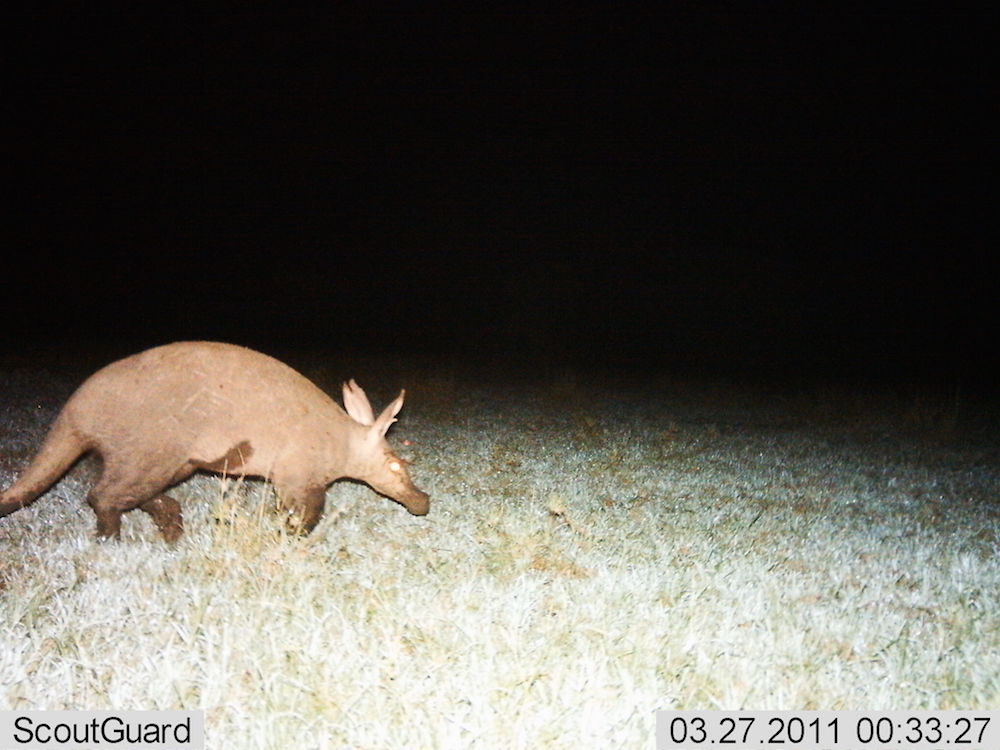Facts About Aardvarks

Aardvarks are mammals that look like they were made from parts of other animals. An aardvark has a long snout that ends with a pig-like nose, rabbit-like ears and a tail similar to a kangaroo's. Yet it is not closely related to any of those animals.
Aardvarks are found throughout sub-Saharan Africa. The aardvark’s name comes from the Afrikaans/Dutch language and means "earth pig," according to National Geographic. Though they do eat ants — so they are technically "ant eaters" — aardvarks are a separate species from anteaters, which are found in South America.
Size
Aardvarks are about the size of a small pig. Typically, they weigh from 110 to 180 lbs. (50 to 82 kilograms). From head to rump, aardvarks are 43 to 53 inches (109 to 135 centimeters) long, and their tail adds another 21 to 26 inches (53 to 66 cm) to its length, according to National Geographic.
If it stuck its tongue out, an aardvark would be much longer. Their tongues can be up to 12 inches (30.5 cm) long. Their ears are also very long and can grow up to 9.5 inches (24 cm) long, according to the Encyclopedia Britannica.

Habitat
Aardvarks live in many different types of habitats, such as grasslands, savannas, rainforests, woodlands and thickets throughout Africa in the areas south of the Sahara.
They tend to avoid very rocky terrain because rocks are difficult to dig in, according to the International Union for Conservation of Nature (IUCN). They live in burrows that range from 6.5 to 42 feet (2 to 13 meters) long, according to Encyclopedia Britannica.
Habits
Aardvarks are solitary animals and only come together to mate. They are also nocturnal, which means they sleep during the day. This helps them escape the heat of the day in their cool burrow. During the night they spend their time working on their burrows or finding food. They may cover distances of 2 to 5 km (1.2 to 3 miles) each night, according to the Animal Diversity Web.
Diet
Aardvarks also dig to get food. They dig into ant and termite mounds and lick up bugs with their long tongues. They eat almost exclusively ants and termites, though they sometimes supplement their diets with other insects like the pupae of scarab beetles. The aardvark’s tough skin protects them from the bites of their meal, according to National Geographic, and their nostrils seal up to keep out dust and insects.
They can eat up to 50,000 insects each night, according to the Wildscreen Arkive. Aardvarks swallow their food whole, without chewing it. Instead, food is ground up in a muscular area of its lower stomach.
According to IUCN, they rarely drink water and receive most of their moisture from the insects they eat.
Offspring
Female aardvarks have a gestation of seven months and give birth to one young at a time. Babies are called calves or cubs. Cubs weigh around 4.4 lbs. (2 kg) when they are born.
Cubs grow up very quickly. At three months they are weaned and at six months they are ready to leave their mothers. At 2 years old, both female and males are sexually mature and ready to have offspring of their own.
Classification/Taxonomy
Here is the classification of aardvarks, according to the Integrated Taxonomic Information System.
Kingdom: Animalia Subkingdom: Bilateria Infrakingdom: Deuterostomia Phylum: Chordata Subphylum: Vertebrata Infraphylum: Gnathostomata Superclass: Tetrapoda Class: Mammalia Subclass: Theria Infraclass: Eutheria Order: Tubulidentata Family: Orycteropodidae Genus: Orycteropus Species: Orycteropus afer
The Tubulidentata order is unique because it is the only order of mammals in which there is only one living representative. Orycteropodidae is the only family in the order, and Orycteropus afer is the only species, according to the ADW.
It used to be thought that aardvarks were closely related to pangolins and armadillos. However, the consensus now is that their resemblance is due to their common adaptation for eating ants. The closest living relatives to aardvarks are now thought to include manatees and elephants, according to the ADW.
Conservation Status
Aardvarks are not threatened and are classified as least concern by IUCN. This is despite the fact that the total population of aardvarks are not known and the population seems to be decreasing in many areas of Africa due to population growth and hunting.
Other Facts
Aardvarks are also called ant bears.
Aardvarks have four toes on the front feet and five toes on their back feet.
Skilled diggers, an aardvark can dig up to 2 f (.6 m) in 15 seconds, according to the African Wildlife Foundation.
Additional resources
Sign up for the Live Science daily newsletter now
Get the world’s most fascinating discoveries delivered straight to your inbox.

